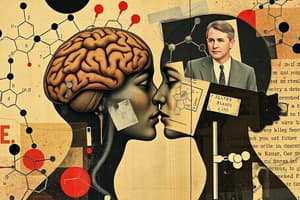Podcast
Questions and Answers
Which brain chemicals are involved in the stage of lust?
Which brain chemicals are involved in the stage of lust?
- Dopamine and serotonin
- Testosterone and estrogen (correct)
- Oxytocin and vasopressin
- Endorphins and adrenaline
What is the evolutionary basis for the stage of lust?
What is the evolutionary basis for the stage of lust?
- Reproduction (correct)
- Emotional connection
- Social bonding
- Physical attraction
Which stage of falling in love involves feeling physically attracted and drawn to the object of affection?
Which stage of falling in love involves feeling physically attracted and drawn to the object of affection?
- Lust (correct)
- Attraction
- Emotional connection
- Attachment
What role does the hypothalamus play in the stage of lust?
What role does the hypothalamus play in the stage of lust?
What are the brain chemicals involved in the stage of attraction?
What are the brain chemicals involved in the stage of attraction?
Flashcards are hidden until you start studying
Study Notes
Stage of Lust
- The stage of lust involves the brain chemicals testosterone and estrogen, which drive libido and sexual desire.
- The evolutionary basis for the stage of lust is to encourage mating and reproduction, ensuring the survival of the species.
- This stage involves feeling physically attracted and drawn to the object of affection.
- The hypothalamus plays a key role in the stage of lust, as it regulates sexual arousal and orgasm.
Stage of Attraction
- The stage of attraction involves the brain chemicals dopamine, serotonin, and norepinephrine, which create feelings of excitement, pleasure, and euphoria.
- During this stage, the brain rewards the release of these chemicals, motivating individuals to continue pursuing the object of affection.
Studying That Suits You
Use AI to generate personalized quizzes and flashcards to suit your learning preferences.




